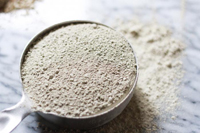Article: How
to Determine if You Have a Quality Clay
by Perry A~ Arledge
 In
the Alternative Health world the question always arises,
"How do I know I am getting the best product?" Here
are some guidelines to help you with your decision on selecting
a quality clay so you won't be fooled by advertising hype. In
the Alternative Health world the question always arises,
"How do I know I am getting the best product?" Here
are some guidelines to help you with your decision on selecting
a quality clay so you won't be fooled by advertising hype.
I find the
proof is in the pudding. Clays in the powder form tend to look
exactly alike yet are different in many ways. Comparison of the
hydrated products gives better insights into the quality of the
clay. The true proof will be found in the results.
Some things to
look for to tell if you have a Quality Clay are:
- Compare side
by side by mixing each clay as a hydrated mask or mud paste
using the manufacturer's directions. Remember to shake well,
do not stir, when mixing clay. Compare them. You want a
smooth textured expanding clay that absorbs water to make a
creamy paste.
- Hold each
jar of clay mask one at a time on the flat palm of your
hand. Tap the side of the jar. Notice if you feel a
vibration. The vibration shows its expansion and creamy
state.
- Compare the
texture. Which one is gritty, and which one is smooth and
creamy? Apply them doing half your face with one clay and
half with the other. When the clays dry, does one side feel
tighter than the other? Does the clay stay on the face, or
does it turn powdery and brush off easily? Which maintains
the strongest pull? The stronger and tighter the hold, the
stronger the pull and detox potential.
- Next,
compare in liquid form, again by using the manufacturer's
directions. Mix clay and water in a glass or food grade
plastic bottle with a plastic lid. Shake well. Let stand for
30 minutes. Once fully mixed, does the clay water stay
emulsified or separate? All clays will have some heavier
particles that settle to the bottom. You want a clay that
stays evenly emulsified. If the clay and water totally
separate, look for a different clay. A quality liquid clay
mixture should have about the consistency of chocolate milk.
It should be tasteless. When holding it in your mouth you
will only feel cool, not sweet, salty, bitter or sour. After
swallowing you will have a slightly chalkiness that will
wash away with a sip of water. If you pour the liquid
mixture in a glass and swirl it around, it should leave a
thin coating on the glass.
- The label
should let you know if you have a Sodium or a Calcium-based
Bentonite/Montmorillonite clay. Calcium Bentonites are more
widely known as healing clays. Avoid the really high sodium
content clays. Clays with over 2% are considered Sodium
clays. Some are as high as 8% or more.
- Make sure
your clay is alkaline with a pH between 8.5 - 10.0 to reduce
acidity and balance the body.
- Needless to
say you want a company where you can easily contact them to
ask questions and talk to a person. Ask for proof as to its
purity, along with an analysis of its primary minerals.
Perry A~
Arledge is the author of Calcium Bentonite Clay Nature's
Pathway to Healing (www.TheClayBook.com)
and numerous clay articles (www.BentoniteClayInfo.com).
She is a frequent guest on health talk radio shows. She is
dedicated to spreading the word about clay's healing potential
and putting attention on safe healing with Bentonite Clay.
She is available for lectures, radio interviews, and answering
questions on clay therapy. Perry A~ can be reached at
1-512-773-0335 and perrya@perrya.com.
© 2015 Perry A~
|

 In
the Alternative Health world the question always arises,
"How do I know I am getting the best product?" Here
are some guidelines to help you with your decision on selecting
a quality clay so you won't be fooled by advertising hype.
In
the Alternative Health world the question always arises,
"How do I know I am getting the best product?" Here
are some guidelines to help you with your decision on selecting
a quality clay so you won't be fooled by advertising hype.

